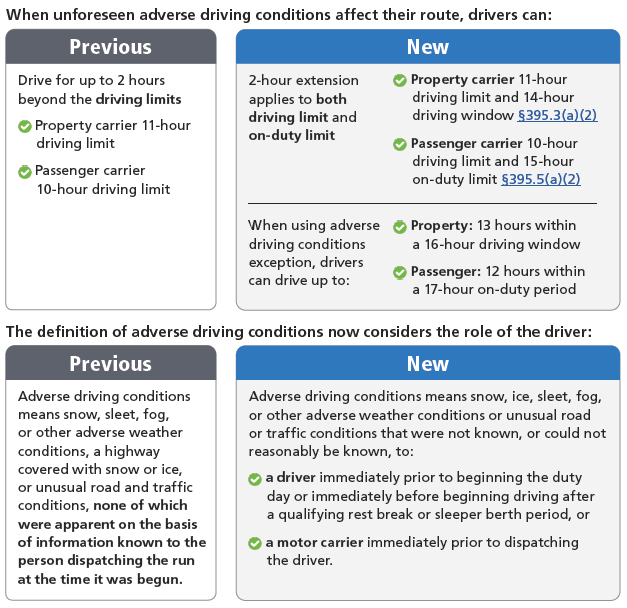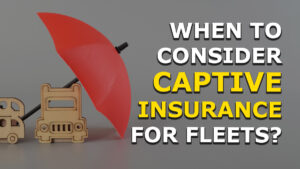
When you drive across the country, fall and winter weather can bring intense storms, heavy snow, high winds, fog, sleet, or freezing rain.
Extreme weather can cause delays, accidents, road shutdowns and more. While drivers are used to planning around storms, it is important to remind drivers what regulations surround extreme weather so we can keep drivers safe and prevent violations and fines.
Below are some tips and quick regulation breakdowns around snow, chains, and other required tools for extreme weather conditions.
Snow and winter travel
Regardless of the weather conditions, drivers are required to reduce speed and–if conditions become too dangerous–drivers must stop and wait until the vehicle can be operated safely again.
When it comes to driving through snow, drivers should be aware that vehicles must be fully clear of ice and snow before winter travel. If snow or ice falls from a moving vehicle and strikes another vehicle or pedestrian causing death or serious bodily injury, the operator of that vehicle could receive a $200 to $1,000 fine.
HAVE A QUESTION ABOUT COVERAGE? WE WILL KEEP YOU SAFE AT EVERY TURN!
It is also important to make sure you are fully fueled up before you start the day and be sure to pack a winter emergency kit.
This winter emergency kit should include:
- ice scraper and small snow shovel
- extra warm clothing, gloves, and blanket
- food and water stored onboard
- hand warmers
- first aid kit
- rock salt or sand
- charged cell phone and charger
Drivers should also tailor their kits to any specific needs that they or their families have, such as extra medication and pet supplies.
Ensure tire chains are stored
Of course, when driving through snow, drivers need to make sure tire chains are safely secured and ready to be used when required by state rules.
States have their own requirements for carrying chains on commercial motor vehicles, or CMVs that are:
- Medium duty: vehicles with a gross vehicle weight (GVW) rating of more than 10,000 pounds to 26,000 pounds such as buses, recreational vehicles, and cargo vehicles
- Solo commercial: vehicles with a GVW rating of 26,001+ pounds not towing
- Commercial vehicles with trailers: vehicles with a GVW rating of 26,001+ pounds towing one or more trailers
Below is a quick summary of state snow chain requirements:
- Alabama: Tire chains or snow tires may be used by any vehicle when required for safety due to snow, rain, or other slippery conditions
- Arizona: Tire chains or snow tires may be used by any vehicle when required for safety due to snow, rain, or other slippery conditions
- California: No specific dates for chains, but signs will be posted when chains are required
- Colorado: Commercial vehicles traveling on certain roads must carry chains from September 1 May 31
- Connecticut: Studded tires and non-skid devices may be used from November 15 – April 30
- Delaware: Tire chains or snow tires may be used by any vehicle when required for safety due to snow, rain, or other slippery conditions
- Florida: no tire chain laws
- Georgia: Tire chains or snow tires may be used by any vehicle when required for safety due to snow, rain, or other slippery conditions
- Hawaii: no tire chain laws
- Idaho: No specific restrictions, it is advised to avoid it unless necessary
- Iowa: Tire chains or snow tires may be used by any vehicle when required for safety due to snow, rain, or other slippery conditions
- Illinois: Tire chains or snow tires may be used by any vehicle when required for safety due to snow, rain, or other slippery conditions
- Indiana: Tire chains or snow tires may be used by any vehicle when required for safety due to snow, rain, or other slippery conditions
- Kansas: Tire chains or snow tires may be used by any vehicle when required for safety due to snow, rain, or other slippery conditions
- Kentucky: May not be used unless road is ice-covered or vehicle has an ice shoe at least 6 in wide. Limit on diameter and spacing
- Louisiana: Tire chains or snow tires may be used by any vehicle when required for safety due to snow, rain, or other slippery conditions
- Maine: Tire chains or snow tires may be used by any vehicle when required for safety due to snow, rain, or other slippery conditions
- Massachusetts: Permitted from November 1 – May 1
- Maryland: Required when snow emergency has been declared, not allowed on vehicles weighing more than 10,000 lbs
- Michigan: Tire chains or snow tires may be used by any vehicle when required for safety due to snow, rain, or other slippery conditions
- Minnesota: Permitted when road conditions call for it. Studded pneumatic tires not allowed on state registered vehicles
- Mississippi: Tire chains or snow tires may be used by any vehicle when required for safety due to snow, rain, or other slippery conditions
- Missouri: no tire chain laws
- Montana: Permitted October 1 – May 1, not mandatory unless notices are posted. Specific regulations for studded tires
- Nebraska: Metal studs only permitted November 1 – April 1. School buses, mail carrier vehicles, and emergency vehicles are permitted year-round
- Nevada: Required on all vehicles over 10,000 lbs when requirements in effect. Studded tires permitted between October 1 – April 30
- New Hampshire: no tire chain laws
- New Jersey: Tire chains or snow tires may be used by any vehicle when required for safety due to snow, rain, or other slippery conditions
- New Mexico: Tire chains or snow tires may be used by any vehicle when required for safety due to snow, rain, or other slippery conditions
- New York: Required when a snow emergency has been declared
- North Carolina: Tire chains or snow tires may be used by any vehicle when required for safety due to snow, rain, or other slippery conditions
- North Dakota: Tire chains or snow tires may be used by any vehicle when required for safety due to snow, rain, or other slippery conditions
- Ohio: Only permitted between November 1 – April 1, except for public safety or school bus.
- Oklahoma: Tire chains or snow tires may be used by any vehicle when required for safety due to snow, rain, or other slippery conditions
- Oregon: Required on vehicles over 10,000 lbs when SNOW ZONE signs are posted
- Pennsylvania: Permitted between November 1 – April 15, restrictions on size of tires or studs
- Rhode Island: Tire chains or snow tires may be used by any vehicle when required for safety due to snow, rain, or other slippery conditions
- South Carolina: Tire chains or snow tires may be used by any vehicle when required for safety due to snow, rain, or other slippery conditions
- South Dakota: Tire chains or snow tires may be used by any vehicle when required for safety due to snow, rain, or other slippery conditions
- Tennessee: Permitted October 1 – April 1, specific regulations on percentage of wire or other material that comes in contact with the road
- Texas: Tire chains or snow tires may be used by any vehicle when required for safety due to snow, rain, or other slippery conditions
- Utah: Between November 1 – March 31, if signs are posted, vehicles must have chains or snow tires
- Vermont: no tire chain laws
- Washington: Signs marked “chains required” will be posted. On certain routes, chains must be carried from November 1 – March 31
- Washington, D.C.: no tire chain laws
- West Virginia: Tire chains or snow tires may be used by any vehicle when required for safety due to snow, rain, or other slippery conditions
- Wisconsin: Tire chains or snow tires may be used by any vehicle when required for safety due to snow, rain, or other slippery conditions
- Wyoming: Signs will be posted indicating when chain laws are in effect, must use adequate snow tires or chains.
Other required tools and regulations
Each CMV (except those towed in a driveaway–towaway operation) must have the following emergency equipment stored onboard:
- fire extinguishers
- spare fuses
- warning devices for stopped vehicles
See 49 CFR 393.95 for full emergency equipment specifications, regulations, and exceptions.
If a vehicle is stopped on a highway or shoulder for a reason other than a necessary traffic stop, the driver must turn on the vehicle’s hazard warning system, which is to be left on until the vehicle’s external warning devices are in position. The hazard warning system must again be utilized when the warning devices are being picked up before the vehicle moves on.
Warning devices (warning triangles, fuse flares, or liquid-burning flares) must be placed within 10 minutes in three locations:
- One on the traffic side, 4 paces (approximately 10 feet) from the vehicle, in the direction of approaching traffic;
- One in the center of the traffic lane or shoulder, 40 paces (approximately 100 feet) from the vehicle, in the direction of approaching traffic; and
- One in the center of the traffic lane or shoulder, 40 paces (approximately 100 feet) from the vehicle, in the direction away from approaching traffic.
If flares are used, the driver is responsible for ensuring that at least one flare remains lit at each location as long as the vehicle is stopped.
Adverse driving conditions exception:
The FMCSA recently released several exception to the Hours of Service rules, including changes to the adverse driving conditions exception.
The adverse driving exception applies to conditions that you did not know about when you started your run–like snow, fog, or a shut-down of traffic due to an accident, but excludes conditions that you should have known about, such as congested traffic during typical rush hour periods.
On September 29, 2020, rule changes will extend both their drive-time limit and their on-duty window by 2 hours if they encounter adverse conditions such as weather or traffic congestion.
According to the FMCSA, the provision will allow drivers to either sit and wait out the conditions or to slowly drive through them with caution.

Drivers are also encouraged to monitor state agency social media accounts for the most up-to-date information on any emergency or weather-related situation affecting the state, in addition to any social media accounts for your local emergency management offices.





